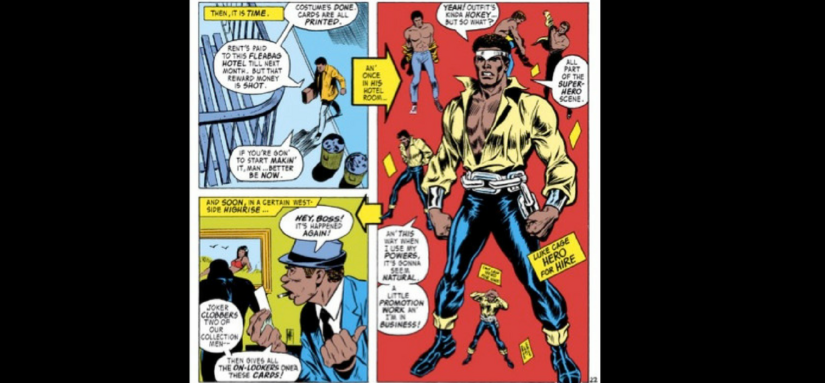Last time in Marvel Firsts, I fell in love with Roy Thomas and Gil Kane’s work on Marvel Premiere #15, which introduced Iron Fist. Thomas’s writing was clever, passionate, and hungry, creating an experience unlike many others I’ve had while reading superhero comics. This time, we’re jumping backwards in time to 1972 for the first appearance of Luke Cage. In his modern appearances, I know him as my favorite Avenger during the Bendis run and a huge part of Marvel’s current roster. Likable and human, powerful and flawed, Luke Cage was one of the first superheroes I became invested in… but I’ve never taken the time back to explore his history. Let’s see what’s going on for Power Man himself in 1972.
Luke Cage first appeared in the self-titled Luke Cage, Hero for Hire #1, written by Archie Goodwin and drawn by George Tuska, with “considerable contributions” from Roy Thomas and John Romita, inks by Billy Graham, and letters by Skip Kohloff. It stands out from the other Bronze Age premieres that I’ve been exploring in a couple of big ways. Namely, it was unlike both The Tomb of Dracula #1, which was a straight forward, plot-driven horror story, and Marvel Premiere #15, which was a stylistically intriguing, non-linear exploration of character. Instead, Luke Cage, Hero for Hire #1 has a lot more in common with modern day superhero fiction in that this first issue entirely sets up everything we have to know about Luke Cage so that the meat and potatoes of the Hero for Hire concept can start with the second issue.
It starts with a man named Lucas being abused at prison by a viciously racist C.O., which the neglectful warden allows. When the prison is brought under new leadership, though, Lucas is singled out as a healthy specimen for a strange experiment by Dr. Noah Burstein. If it goes well, Lucas could be up for parole as a reward… if it goes the other way, he could die. Weighing his options, Lucas decides to sit down with Burstein and tell him about his past. From here, we learn about his life before prison, which is a pretty interesting story – though, I am starting to notice that every Bronze Age story has a conflict centering around two former male friends fighting over a woman. I’m not sure if it’s a coincidence, but it’s present in the three I’ve read so far, and seems to be a weirdly specific trend.
Anyway, the flashback nicely sets up a conflict between Lucas and Willis Stryker (Diamondback!) and then gets back to the choice Lucas must make. He ends up agreeing to take the chemical bath, but things go awry when the racist C.O. interferes with the chemicals. Lucas emerges alive, and is shocked to discover that he is both strong as hell and physically invulnerable delivering a minor blow to the C.O. almost kills the guy. Realizing that he’s lost his chance at parole, he punches through the wall and escapes. After an incident on the street shows Lucas that he can make a living by fighting crime, he opens up a business as, you guessed it, a hero for hire and changes his name to Luke Cage, so that he will never forget how he was treated in that cage of a prison.
This is a hell of an interesting way to end, with Luke Cage introduced as a self-employed hero and Diamondback on the streets, ready to hunt down his childhood friend. The prison story and Luke’s flashback is one-hundred percent essential in making this concept work, but the best part about the issue is most certainly the promise of the awesome stories to come with this entirely new take on a superhero.






Comments are closed.